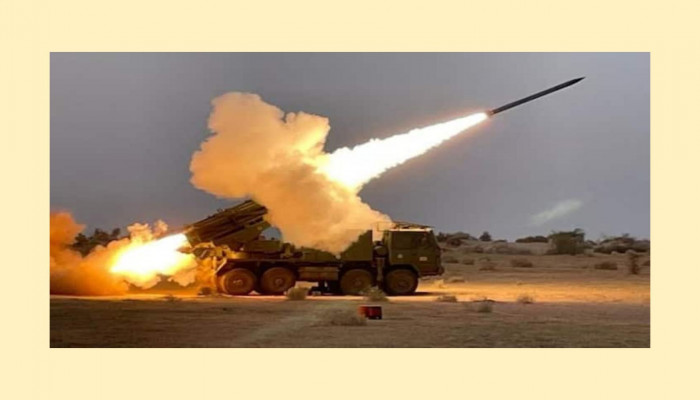France shows interest in India’s Pinaka barrel system
- In Reports
- 11:50 PM, Nov 09, 2024
- Myind Staff
India’s Pinaka Multi-Barrel Rocket Launcher System (MBRLS), the country’s first major defence export, has drawn significant international attention. Armenia recently selected the Pinaka system, comparable to the American HIMARS, to strengthen its defences against Azerbaijan. Now, France is also evaluating the Pinaka for its land forces. During a recent visit to India, Brigadier General Stephane Richou of the French Army disclosed this interest.
“We are evaluating Pinaka because we need a system like that and evaluating this among the other systems of the highest countries… This is much more than a business partnership, this is cooperation,” Brigadier Richou told an Indian news agency.
Highlighting the strategic partnership between India and France, the visiting two-star French Army officer noted that the two nations are already "sharing equipment," such as Rafale fighter jets and Scorpene submarines. “For us, the industry of Indian defence is very effective. We are looking at the capacities offered by India as much as we are looking at the capacities of the highest countries providing equipment,” Brigadier Richou added.
In early 2024, during French President Emmanuel Macron’s visit to India, the two nations finalised a deal to jointly produce defence equipment, including helicopters and submarines, for the Indian armed forces and for export to friendly countries. The agreement includes plans to establish maintenance, repair, and overhaul (MRO) services in India by France’s Safran for its leading-edge aviation propulsion (LEAP) engines, with additional MRO support for Rafale engines and a helicopter collaboration.
Additionally, India’s Tata Group and France’s Airbus have signed an agreement to manufacture civilian helicopters together. The Pinaka Mk-1 is a free-flight artillery rocket system designed for area bombardment, with a range of 38 kilometres, a quick reaction time, and a high rate of fire. Capable of firing 12 rockets in just 44 seconds from a single multi-barrel launcher, a full battery can deliver a volley of 72 rockets in moments.
Developed as a replacement for the Russian GRAD BM-21, the Pinaka Mk-1 meets the demands of a modern, drone-saturated battlefield with its “Shoot-and-Scoot” capability, allowing it to rapidly fire and relocate, evading counter-battery fire. The system’s support vehicles offer similar mobility and logistical integration.
The export contract with Armenia marks India’s first major sale of an indigenous system developed by the Defense Research and Development Organisation (DRDO), with the Pinaka MBRLS containing nearly zero imported components. The Pinaka multiple rocket launcher is currently in service with the Indian Army and has been deployed along the borders with China and Pakistan.
Named after the divine bow of Bhagwan Shiva, the Pinaka rocket system saw its first combat action during the 1999 Kargil conflict against Pakistan. In the intense battles across the icy Himalayan mountains, Pinaka played a critical role in neutralising Pakistani positions on high-altitude peaks.
“The best feature of the Pinaka system is that one regiment can launch as many as 12 rockets in under a minute in multiple directions, and then the regiment can be re-located within minutes,” an official familiar with the system told the EurAsian Times.
A key advantage of the Pinaka launcher is its ability to operate independently, with rockets fired either individually or simultaneously in different directions. The system supports four operational modes: manual, remote, standalone and autonomous.
The complete Pinaka MBRL system includes six launcher vehicles, each carrying 12 rockets, along with six loader-replenishment vehicles, two command post vehicles integrated with a fire control computer, and a DIGICORA MET radar.
The DRDO is currently developing an upgraded version of Pinaka with an extended range of 60 to 90 kilometres. Additionally, it is testing a guided version of the Pinaka rocket, capable of ranges between 70 and 90 kilometres.
France is India’s second biggest defence supplier after Russia, and it does not forget to remind India that it has been steadfast in its defence ties with India. “We have stood by your side through thick and thin,” Safran’s chair, Ross McInnes, assured an audience at India’s Defence Conclave at the beginning of October. “The same cannot be said of your other Western partners,” he added, noting that France was the only Western country that stood with India after the US-led sanctions in the aftermath of 1998 nuclear tests sought to cripple its economy.
In the last decade, France has emerged as India’s largest arms supplier after Russia. However, since the Ukraine conflict, sanctions have made it challenging for India to source arms from Russia, a situation likely to strengthen defence ties between India and France.
From 2017 to 2021, India was France’s top arms buyer, accounting for 29 percent of French arms exports. This growing defence partnership, along with collaborations like the Pinaka and joint initiatives on maintenance and overhaul services, shows how deeply aligned India and France have become in building robust, strategic alliances. The increase in India’s arms imports from France is elevating France’s position in the global arms market, challenging Russia for the spot as the world’s second-largest arms exporter while the United States remains first.
For years, the French omni-role Rafale fighter jet struggled to attract buyers. Aside from modest orders from Egypt and Qatar, its order book remained sparse, having lost contracts in Belgium, Brazil, Canada, Finland, Kuwait, Singapore and Switzerland, largely due to its high cost.
The tide turned in 2012 when the Indian Air Force (IAF), the world’s fourth-largest, selected the Rafale over the Eurofighter Typhoon. India’s decision sparked renewed interest in the Rafale, leading to a historic contract with the UAE for 80 jets.
India purchased Rafales through a direct government-to-government deal with France. The jets joined the Indian Air Force shortly after a tense border standoff with China, and within days of their arrival, they were deployed in Ladakh, where Indian forces were engaged in a significant skirmish with the PLA.







Comments